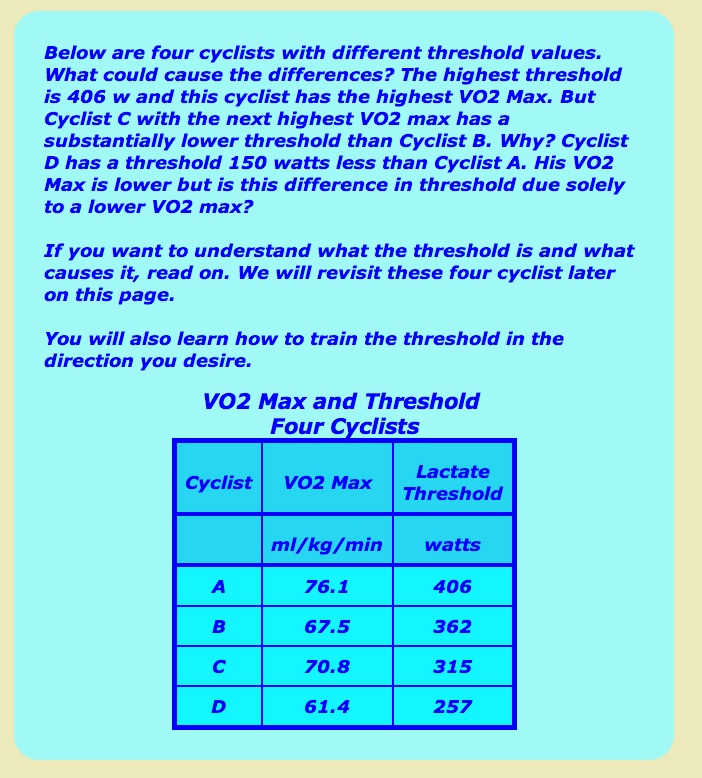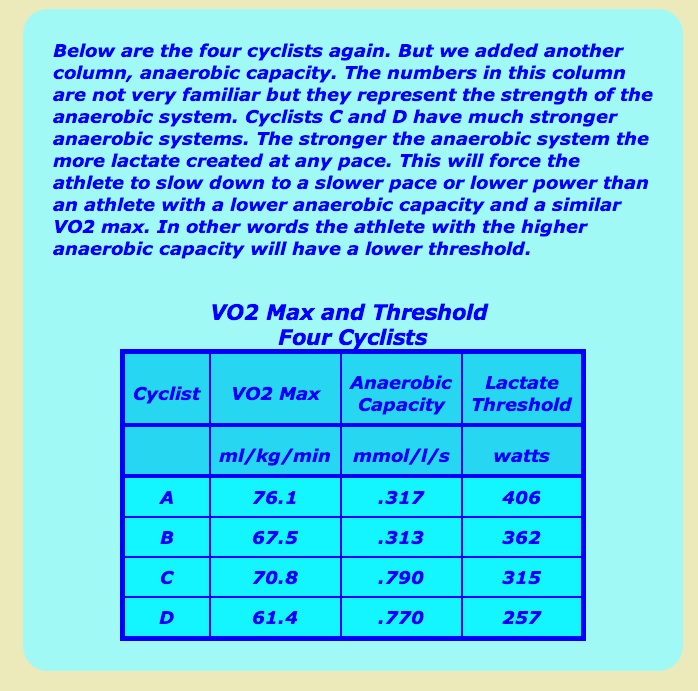Quote:
I take that to mean that you're a strong believer in lots and lots of VO2max intervals for all athletes, endurane or not? After all, your claim seems to be that VO2max is the primary determinant of performance at all durations ("the main driver is VO2max").
Thank you for asking the question. Blogs are certainly not the place for complete exactitude. However, my guess is that the vast numbers will never see these exchanges.
The MMP curve is essentially a series of races from a few seconds up to I guess several hours. Nobody probably does any more than a few points on this curve though I would be interested in any here who read this just how often they actually do the various times/distances.
We discuss on our triathlon website in a brief way this concept in a page titled
"What does it mean to be faster in a race?"
http://www.lactate.com/...riathlon_faster.html
We take the point of view that each point on the MMP curve (though it is a term I have never used) is determined primarily by three metabolic factors: aerobic capacity, anaerobic capacity (using VLA max as the definition) and creatine phosphate.
If one wants to delve into the energy contribution of various races, the obvious answer is that the results are due to the strength of these three energy systems plus some other factors such as muscle strength. There is a lot of literature on this and it varies by researchers as to the contribution of each of the systems at the various time frames. I sat through a presentation on this by Uli Hartmann last December and he showed differences between what US and European researchers have found on this.
I once asked Jan Olbrecht about this and he replied for a 50 m freestyle or about 21-24 seconds aerobic capacity had almost no factor in the race. Whatever oxygen was used was already in the blood or muscles and while the swimmer obviously breathes during the race, the oxygen did not get to the muscles.
But he said that these swimmers spend most of their time training aerobically. Why? His answer was that they needed to be strong aerobically in order to do the other workouts efficiently that would lead to success in these races.
For the first 10 seconds, it is mostly creatine phosphate with some glycolysis and for the next 20 seconds, it is mostly glycolysis. After 40 seconds the races are strongly affected by VO2 max. World champions at these distances will almost certainly have high VO2 maxes. But what determines one VO2 max from another in how well they will do in these races is anaerobic capacity.
From a few minutes up to extreme distances the VO2 max will be the primary driver of performance but not the only one. Anaerobic capacity is always there, providing a lot of the energy at the shorter end and then determining how much of VO2 max can be accessed at the higher end.
Hope this clarifies things. And by the way, I am just the messenger here, providing what I have found to be the most consistent system to explain performance at both ends of the MMP curve.
When we first got involved in this business we searched for anyone who could explain it to us. It wasn't till we found Olbrecht 2 1/2 years after we started that we found someone who made sense out of it all. And by that time I had read about a thousand documents on it including many with Coyle's and your name on it.
As far as VO2max intervals, certain types of intervals are obviously beneficial for all athletes but by far, most of the training will be at lower intensities and this has the effect of building VO2 max too. Probably few track sprinters do low intensity stuff, possibly fearing it will erode anaerobic capacity. Swimmers don't have that problem. There are lots of philosophies on training.
I suggest you read Olbrecht's book if you want to understand his approach to training. His ideas are 1) a different perspective on energy metabolism from most, one that explains a lot of things; 2) a system on how to test these energy systems which is definitely different from everyone else; and 3) a system of training the various energy systems reflecting differences in fiber type.
It is this third part that most here are interested in. Many coaches and athletes just want to know how hard, how long and how often and whether intervals should be short or long or the rest short or long. There is obviously mechanical things that have to be trained.
----------
Jerry Cosgrove
Sports Resource Group
http://www.lactate.com https://twitter.com/@LactatedotCom


